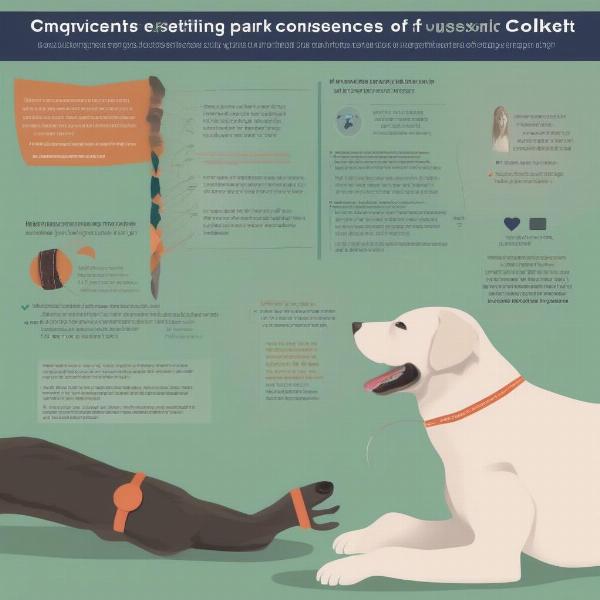Dog bark shock collars are devices designed to curb excessive barking in dogs. They deliver a mild electric shock when the dog barks, aiming to create a negative association with the behavior. While they can be effective for some dogs, their use is controversial and requires careful consideration. Understanding how these collars work, their potential risks, and alternative training methods is crucial for responsible pet ownership.
How Dog Bark Shock Collars Work
These collars typically employ a microphone to detect barking. Once a bark is registered, the collar delivers a stimulus. This can range from a vibration or a spray of citronella to a static shock. Some collars offer multiple settings, allowing owners to adjust the intensity of the stimulus. More advanced models may even incorporate bark recognition technology to differentiate between the dog’s bark and other environmental noises.
Types of Bark Shock Collars
There are several types of bark shock collars, each employing a different stimulus:
- Static Shock Collars: These deliver a brief, low-level electric shock. They are the most controversial type due to the potential for discomfort and psychological distress.
- Vibration Collars: These collars vibrate when the dog barks, providing a less intense deterrent than a shock.
- Citronella Spray Collars: These release a burst of citronella spray near the dog’s nose when they bark. The scent is unpleasant for most dogs, discouraging barking without causing physical discomfort.
- Ultrasonic Collars: These emit a high-pitched sound that is only audible to dogs, interrupting their barking.
Potential Risks and Side Effects
 Potential Side Effects of Using a Bark Shock Collar
Potential Side Effects of Using a Bark Shock Collar
While shock collars can be effective in reducing barking, they carry potential risks:
- Physical Discomfort and Pain: Improper use or high settings can cause pain and burns.
- Psychological Distress: Shock collars can create fear and anxiety, potentially worsening behavioral issues.
- Increased Aggression: Some dogs may react aggressively to the shock, exacerbating behavioral problems.
- Malfunction: Collars can malfunction, delivering shocks inappropriately or failing to function altogether.
Alternatives to Shock Collars
Several humane and effective alternatives to shock collars exist:
- Positive Reinforcement Training: Reward desired behaviors like quietness with treats and praise.
- Desensitization and Counterconditioning: Gradually expose the dog to barking triggers while providing positive reinforcement.
- Addressing Underlying Anxiety: Identify and address any underlying anxiety or stress that may be contributing to the barking.
- Environmental Enrichment: Provide plenty of mental and physical stimulation to reduce boredom-related barking.
Are Shock Collars Right for Your Dog?
Deciding whether to use a shock collar is a complex decision. Consult with a certified professional dog trainer or veterinarian to assess your dog’s individual needs and explore alternative training methods. They can provide guidance on the most appropriate approach for your dog’s specific situation.
Conclusion
Dog bark shock collars can be a quick fix for excessive barking, but they are not without controversy. Understanding the potential risks and exploring alternative training methods is crucial for responsible pet ownership. Prioritize your dog’s well-being and seek professional guidance before considering a shock collar.
FAQ
- Are bark shock collars cruel? Their use is debated. While some owners find them effective, many experts believe they can be harmful, causing pain and psychological distress.
- Can shock collars be used on puppies? Generally, shock collars are not recommended for puppies. Positive reinforcement training is a much more effective and humane approach.
- What are the best alternatives to bark shock collars? Positive reinforcement training, desensitization, and addressing underlying anxiety are often more effective and humane.
- Do bark shock collars work for all dogs? No, they are not universally effective. Some dogs may become habituated to the shock or experience negative psychological effects.
- How do I choose the right bark collar for my dog? Consult with a veterinarian or certified professional dog trainer. They can help you assess your dog’s needs and choose the most appropriate option, if necessary.
- Can a shock collar make my dog more aggressive? Yes, it’s possible. Some dogs may react aggressively to the shock, worsening behavioral problems.
- What should I do if my dog’s barking doesn’t improve with a shock collar? Consult with a veterinarian or professional dog trainer. They can help identify the underlying cause of the barking and recommend alternative solutions.
ILM Dog is a leading international website dedicated to providing expert advice on all aspects of dog care and wellbeing. From breed selection and health advice to training tips and product recommendations, we offer comprehensive resources for dog owners worldwide. We are committed to promoting responsible pet ownership and helping you build a strong, loving bond with your canine companion. For personalized guidance on choosing the right products or addressing specific behavioral issues, contact our team of experts at [email protected] or call us at +44 20-3965-8624. ILM Dog is your trusted source for all things dog.